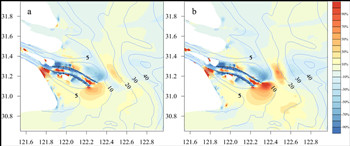The influence of human activities on morphodynamics and alteration of sediment source and sink in the Changjiang Estuary
Several works have discussed the morphological evolution in the Changjiang Estuary (CJE) in recent years. The erosion of its subaqueous delta in recent decades has been ascribed to a decline in fluvial sediment input. However, the interaction between the reduction of riverine sediment load and human activities in the estuary that could have causedmorphological change has not been considered. In thisworkwe provide evidence on themorphological evolution around the delta front zone since 1986 and use a numericalmodel to explore the correlation between the change in hydrodynamics and the evolution pattern. Bathymetric data analysis suggests a decrease of net accretion rate from 16.7 mm/year (1986–1997) to 9.1 mm/year (1997–2010) in the study area. Spatially,
the tidal flats accreted whereas the subaqueous delta switched from deposition between 1986 and 1997 to erosion between 1997 and 2010. We used two indicators, tidal energy dissipation and erosion rate, to quantify the change in hydrodynamics and found that the erosion of the subaqueous delta in recent decades can readily be explained by the alteration of the hydrodynamics. The newly built navigation training works in the North Passage had a significant effect on the estuarine hydrodynamics, resulting in a local morphological adjustment. This erosion generated a new source of sediments to maintain the high suspended sediment concentration and tidal flat progradation. The erosion of the subaqueous delta may continue and gradually slow down until the altered hydrodynamics and morphology reach an equilibrium state in the future.
the tidal flats accreted whereas the subaqueous delta switched from deposition between 1986 and 1997 to erosion between 1997 and 2010. We used two indicators, tidal energy dissipation and erosion rate, to quantify the change in hydrodynamics and found that the erosion of the subaqueous delta in recent decades can readily be explained by the alteration of the hydrodynamics. The newly built navigation training works in the North Passage had a significant effect on the estuarine hydrodynamics, resulting in a local morphological adjustment. This erosion generated a new source of sediments to maintain the high suspended sediment concentration and tidal flat progradation. The erosion of the subaqueous delta may continue and gradually slow down until the altered hydrodynamics and morphology reach an equilibrium state in the future.
Fig.3. Spatial distribution of erosion and deposition in the study area (a: 1986–1997, b: 1997–2010). Contours are the isobaths of 1997.
Fig. 8. Difference in erosion rate between model runs with and without training walls in 1997 (a: dry season; b: wet season). Contours are the isobaths in 1997.
Fig. 7. M2 tidal constituent-induced residual current in the dry season (top: surface residual current; bottom: bottom residual current; a, c: 1997; b, d: 1997 with training walls).
List of relate publications:
-
GEOMORPHOLOGY ,
2016 ,
273
: 52-62



